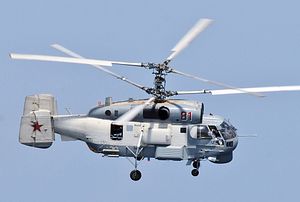The Russian Pacific Fleet conducted an anti-submarine warfare (ASW) exercise in the Sea of Japan earlier month, according to the Russian Navy. The drill, which took place in the Peter the Great Gulf, involved a number of aircraft, surface warships, and at least one submarine.
“In the Peter the Great Gulf, ships from the Primorskaya Flotilla of the Russian Pacific Fleet have held drills on locating and destroying an ‘enemy’ submarine,” a Pacific Fleet spokesperson was quoted as saying by TASS news agency on June 4. “Among ships that took part in the drills were the Varyag guided missile cruiser, the Bystry destroyer and the Admiral Panteleyev large anti-submarine ship.”
The Varyag is a Slava-class guided missile cruiser and the Pacific Fleet’s flagship. The Soviet-era warship is capable of launching the Kamov Ka-27 ASW helicopter, which can carry up to four APR-3E light acoustic homing torpedoes or four groups of Zagon-1 anti-submarine corrected air bombs.
The Bystry is a Sovremenny class guided-missile destroyer primarily used for fleet air defense, and one of the few ships of the class still in active service with the Russian Navy. The Admiral Panteleyey is an Udaloy-class destroyer, classified by the service as a “large anti-submarine ship” and capable of launching SS-N-14 Silex anti-submarine missiles.
The Pacific Fleet used a Type 877 Kilo-class diesel-electric attack submarines (SSK) as a stand-in for the enemy submarine. The submarine during the June drill was reportedly attacked with depth charges and torpedoes dropped from aircraft and launched from surface combatants.
Kilo-class subs are routinely used for ASW drill by the Russian Navy. The Pacific Fleet is expected to receive six improved Project 636.3 Kilo-class (aka Vashavyanka-class) SSKs by 2021. As I explained in September 2016:
The Project 636.3 Kilo-class is an improved variant of the original Project 877 Kilo-class design. The updated version is slightly longer in length — the sub’s submerged displacement is around 4,000 tons — and feature improved engines, an improved combat system, as well as new noise reduction technology. The submarine has a crew of around 50 and can conduct patrols for up to 45 days.
The exercise also involved the Ilyushin Il-38/N “Dolphin” maritime patrol/ASW aircraft, which was used for locating and tracking the submarine. The Il-38N is an improved version of the original Il-38 and has reportedly been fitted with the new Novella maritime surveillance mission system, enhancing the aircraft’s electronic reconnaissance and tracking capabilities.
The Russian Pacific Fleet has been conducting a number of ASW exercises in recent months. The service held exercises on April 30 and April 19 in the Arctic Ocean and in waters off the Russian territory of Khabarovsk in the country’s Far East, respectively. The fleet is slowly rebuilding its ASW capability after years of neglect following the collapse of the Soviet Union.

































